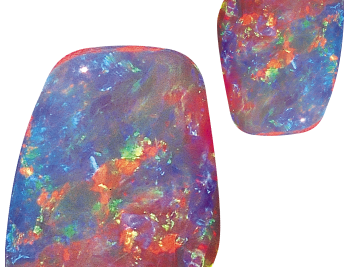About Opal
Natural Opal
Natural Opal is those which was formed in natural environment and has not been enhanced or treated in any way other than by cutting and polishing. Natural opals are usually described as boulder, dark/black, matrix and light. The variety of natural opal is determined by the two characteristics of body tone and transparency.
Body Tone - Refer to the relative darkness or lightness of the opal ranging from colourless, white, through the various shades of grey, to black.
Transparency - Opal shows all forms of diaphaneity that range from transparent to translucent to opaque. When natural precious opal is transparent to semi-transparent, and the colour clarity is sharp, it is often referred to as crystal opal.
Boulder Opal
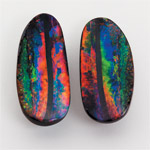
Boulder opal is also classified as solid opal. It is a variety of precious opal that has the host rock forming naturally as part of the gem. This type of opal is often cut with the ironstone left on the back, as the opal often just a thin vein of precious opal is present. It mainly occurs in specific locations over a wide area of Western Queensland. The opal forms within the cavities of the boulders in both vertical and horizontal cracks. Boulder opal can be found in many different shapes and sizes, from as small as a pea, to as big as a family car which can also be black or light depending on the appearance of the stone when viewed from the surface.
The popularity of this type has soared since the mid 1970s. Boulder opals are invariably cut incorporating the host brown ironstone; they are in high demand and can be extremely valuable. A variety of boulder opal also occurs in Andamooka , South Australia , where the host rock is quartzite. These are called "painted ladies", but are normally only suitable as specimens.
Black/Dark Opal
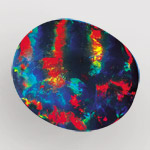
Black Opal is easily distinguished by the blackness of the background "body tone" or body colour which shows a play of colour within or on a black/dark body tone, when viewed from the face up.
The term 'black opal' does not mean that the stone is completely black, some of them have a light crystal colour bar on dark opal potch (colourless opal), giving the otherwise light opal a dark appearance. Even expensive black/dark opals may have only a very thin colour bar on black potch.
Most black/dark opal is found in the mines around NSW, Lightning Ridge. Because of its relative scarcity compared to light and even boulder opal, it tends to be more expensive, given equivalent colours, clarity and patterns.
Matrix Opal
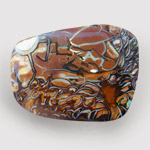
Matrix opal is where the opal occurs as a network of veins or infilling of voids or between grains of the host rock.
Boulder matrix opal is found in Queensland and can be distinguished by the ironstone host rock.
Andamooka matrix opal is a porous material from Andamooka, South Australia, which is often treated to enhance the colour by depositing black carbon by chemical treatment in the pore spaces in the stone.
Light/Crystal Opal
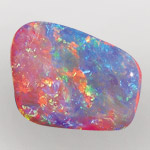
Crystal Opal has a transparent, translucent, or semi-translucent body which is also referred to as the "diaphaneity" of a stone. Crystal opals can display any colour of the spectrum in a beautiful play of colour because they are cut with a high cabochon.
The translucence of a crystal opal often gives it clarity and vibrancy of colour and may be transparent through to nearly opaque, although it usually has a "milky" appearance and has a light body tone or white body colour.
The first deposits of Crystal opal was found at White Cliffs (NSW) but mainly mined at Coober Pedy and Mintabee, (South Australia).

Opal Association Member
The Opal Association is based in Australia and has industry members from around the world. It is administered by an executive committee that meets quarterly. The Association has subsequently attracted a diverse membership of opal miners, cutters, manufacturers, wholesalers and retailers of many year experience.

